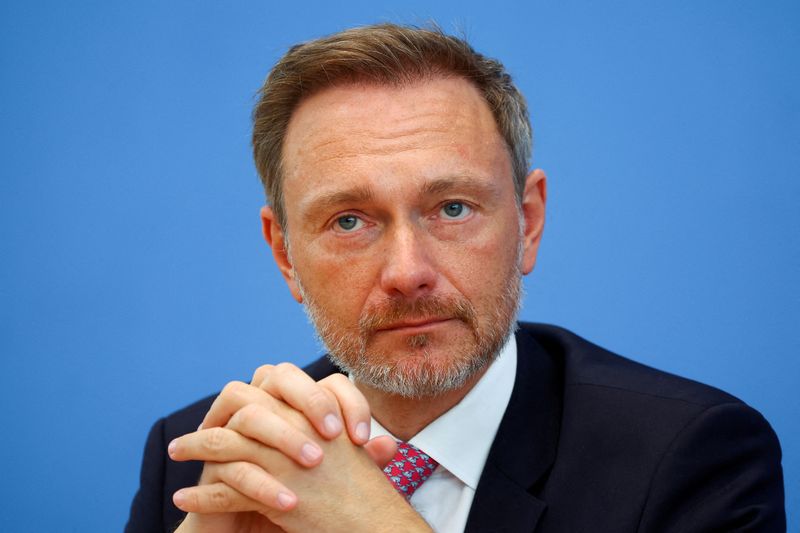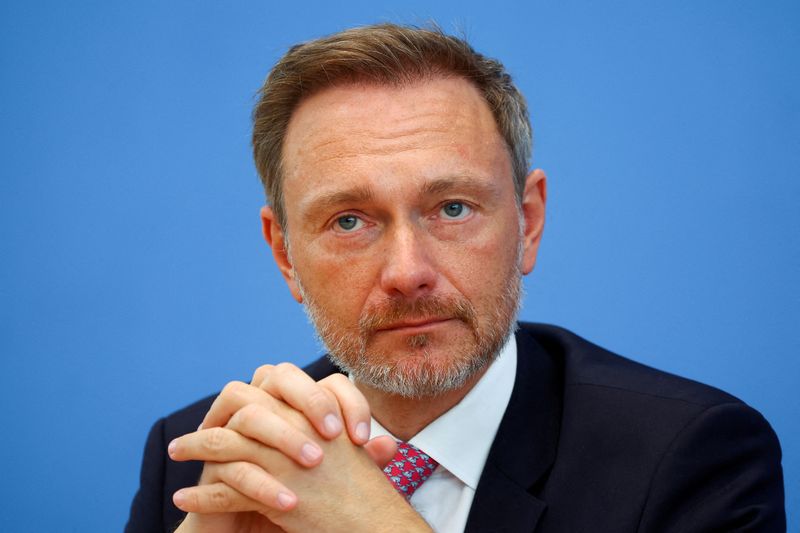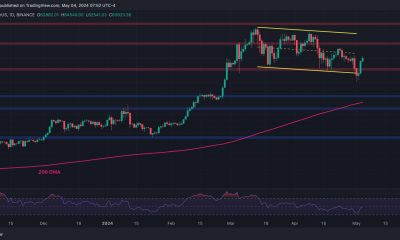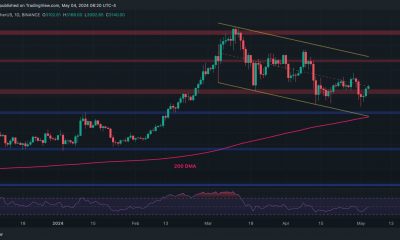Economy
Germany plans $18.1 billion in new borrowing for 2024 – sources


© Reuters. FILE PHOTO: German Finance Minister Christian Lindner at the House of ‘Bundespressekonferenz’ in Berlin, Germany June 14, 2023. REUTERS/Fabrizio Bensch/File Photo
By Holger Hansen and Maria Martinez
BERLIN (Reuters) -German Finance Minister Christian Lindner is planning 16.6 billion euros ($18.1 billion) of net new debt for the 2024 federal budget, which includes record spending on defence, finance ministry sources said on Monday.
The financial plan to 2027 shows new borrowing falling to 15.0 billion euros by that year. But the sources estimate there is still a gap of 14.4 billion euros in the medium-term budget plan as Lindner tries to balance fiscal responsibility with spending demands from within the three-party ruling coalition.
Expenditure of 445.7 billion euros is planned for next year, after 476.3 billion estimated for 2023. The plans include 54.2 billion euros in investments in 2024.
The finance ministry aims to submit a first draft of the 2024 federal budget and financial planning proposals to cabinet on Wednesday, after postponing presentations initially set for March and June due to disputes inside the coalition.
The months-long stalemate between the left-leaning Social Democrats, liberal Free Democrats and the Greens has at times exposed deep tensions within the government and cast uncertainty over spending plans in Europe’s largest economy.
Germany plans to comply with NATO’s 2% of gross domestic product (GDP) target for military spending in 2024, with 51.8 billion euros budgeted for defence and 19.2 billion in extra budgetary funds for the armed forces.
Germany’s parliament suspended the constitutionally enshrined debt brake between 2020 and 2022 to allow for extra spending in response to the pandemic and the effects of the war in Ukraine.
This year, the debt brake was re-implemented. For 2023, new debt of around 45.6 billion euros is planned.
Next year, the debt break will limit the budget deficit to 0.35% of GDP.
The sources said interest costs were estimated at 36.9 billion euros in 2024, three billion less than planned for 2023.
WHY THE DELAY, AND WHAT NEXT?
Lindner postponed the presentation of the first draft without giving a new date, saying other ministers were asking for too much money for their departments.
The finance ministry says the budget needs to be reined in significantly following massive spending during the pandemic and due to higher energy costs as a result of the Ukraine war.
“Fiscal policy and monetary policy need to go hand-in-hand,” Lindner has said repeatedly, referring to European Central Bank interest rate hikes to fight inflation.
Other ministries, however, have said they need more funds for digital transformation and the energy transition.
After Lindner’s first proposal, a detailed budget draft could be sent to the Bundestag, or lower house of parliament, by mid-August at the latest.
In the first week of September, the Bundestag could then discuss the draft in a plenary session for the first time.
The Bundestag’s deliberations involve three readings. Chancellor Olaf Scholz has promised it will pass a budget bill by the end of the year.
($1 = 0.9191 euros)
Economy
Russian central bank says it needs months to make sure CPI falling before rate cuts -RBC


© Reuters. Russian Central Bank Governor Elvira Nabiullina attends a news conference in Moscow, Russia June 14, 2019. REUTERS/Shamil Zhumatov/File Photo
MOSCOW (Reuters) – Russia’s central bank will need two to three months to make sure that inflation is steadily declining before taking any decision on interest rate cuts, the bank’s governor Elvira Nabiullina told RBC media on Sunday.
The central bank raised its key interest rate by 100 basis points to 16% earlier in December, hiking for the fifth consecutive meeting in response to stubborn inflation, and suggested that its tightening cycle was nearly over.
Nabiullina said it was not yet clear when exactly the regulator would start cutting rates, however.
“We really need to make sure that inflation is steadily decreasing, that these are not one-off factors that can affect the rate of price growth in a particular month,” she said.
Nabiullina said the bank was taking into account a wide range of indicators but primarily those that “characterize the stability of inflation”.
“This will take two or three months or more – it depends on how much the wide range of indicators that characterize sustainable inflation declines,” she said.
The bank will next convene to set its benchmark rate on Feb. 16.
The governor also said the bank should have started monetary policy tightening earlier than in July, when it embarked on the rate-hiking cycle.
Economy
China identifies second set of projects in $140 billion spending plan


© Reuters. FILE PHOTO: Workers walk past an under-construction area with completed office towers in the background, in Shenzhen’s Qianhai new district, Guangdong province, China August 25, 2023. REUTERS/David Kirton/File Photo
SHANGHAI (Reuters) – China’s top planning body said on Saturday it had identified a second batch of public investment projects, including flood control and disaster relief programmes, under a bond issuance and investment plan announced in October to boost the economy.
With the latest tranche, China has now earmarked more than 800 billion yuan of its 1 trillion yuan ($140 billion) in additional government bond issuance in the fourth quarter, as it focuses on fiscal steps to shore up the flagging economy.
The National Development and Reform Commission (NDRC) said in a statement on Saturday it had identified 9,600 projects with planned investment of more than 560 billion yuan.
China’s economy, the world’s second largest, is struggling to regain its footing post-COVID-19 as policymakers grapple with tepid consumer demand, weak exports, falling foreign investment and a deepening real estate crisis.
The 1 trillion yuan in additional bond issuance will widen China’s 2023 budget deficit ratio to around 3.8 percent from 3 percent, the state-run Xinhua news agency has said.
“Construction of the projects will improve China’s flood control system, emergency response mechanism and disaster relief capabilities, and better protect people’s lives and property, so it is very significant,” the NDRC said.
The agency said it will coordinate with other government bodies to make sure that funds are allocated speedily for investment and that high standards of quality are maintained in project construction.
($1 = 7.1315 renminbi)
Economy
Russian central bank says it needs months to make sure CPI falling before rate cuts -RBC


© Reuters. Russian Central Bank Governor Elvira Nabiullina attends a news conference in Moscow, Russia June 14, 2019. REUTERS/Shamil Zhumatov/File Photo
MOSCOW (Reuters) – Russia’s central bank will need two to three months to make sure that inflation is steadily declining before taking any decision on interest rate cuts, the bank’s governor Elvira Nabiullina told RBC media on Sunday.
The central bank raised its key interest rate by 100 basis points to 16% earlier in December, hiking for the fifth consecutive meeting in response to stubborn inflation, and suggested that its tightening cycle was nearly over.
Nabiullina said it was not yet clear when exactly the regulator would start cutting rates, however.
“We really need to make sure that inflation is steadily decreasing, that these are not one-off factors that can affect the rate of price growth in a particular month,” she said.
Nabiullina said the bank was taking into account a wide range of indicators but primarily those that “characterize the stability of inflation”.
“This will take two or three months or more – it depends on how much the wide range of indicators that characterize sustainable inflation declines,” she said.
The bank will next convene to set its benchmark rate on Feb. 16.
The governor also said the bank should have started monetary policy tightening earlier than in July, when it embarked on the rate-hiking cycle.

 Forex2 years ago
Forex2 years agoForex Today: the dollar is gaining strength amid gloomy sentiment at the start of the Fed’s week

 Forex2 years ago
Forex2 years agoHow is the Australian dollar doing today?

 Forex1 year ago
Forex1 year agoUnbiased review of Pocket Option broker

 Forex2 years ago
Forex2 years agoDollar to pound sterling exchange rate today: Pound plummeted to its lowest since 1985

 Cryptocurrency2 years ago
Cryptocurrency2 years agoWhat happened in the crypto market – current events today

 World2 years ago
World2 years agoWhy are modern video games an art form?

 Stock Markets2 years ago
Stock Markets2 years agoMorgan Stanley: bear market rally to continue

 Economy2 years ago
Economy2 years agoCrude oil tankers double in price due to EU anti-Russian sanctions

































